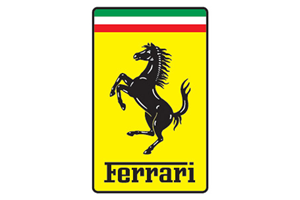


This edition of the Ferrari 412 i 4.9 V12 is the 5 speed / Manual version and was first brought out in 1986. This was at around the same time as the introduction of the 1987 Porsche 959 Turbo and the 1987 Ferrari F40 2.9 V8.This particular Ferrari 412 has a 4942cc Naturally Aspirated Petrol powerplant with 12 cylinders in a V formation.
The 412 shares its Petrol V12 engine configuration with the likes of the 2021 Aston-Martin Valkyrie Spider 6.5 V12 and the 2021 Aston-Martin Valkyrie Coupe 6.5 V12. If you're looking for other fast cars which share the 412's Rear Wheel Drive, Coupe combination then how about the 1982 Fiat X1/9 1.5 8V or the 1965 Aston-Martin DB6 1965.
Weighing in at 1805 kgs (3979 lbs) this makes the Ferrari 412 i 4.9 V12 in the same weight category as the 2022 Aston-Martin Vantage V12 5.2 Twin Turbo or the give or take 50kg.
In terms of power the 4942cc 24V V12 engine produces 335 bhp (249 kW) @ 6000 rpm similar to the 2024 Mazda CX-90 S 3.3 Turbo (340 bhp) or the 2023 Porsche Cayenne Coupe 3.0 V6 Turbo (348 bhp).
The Naturally Aspirated V12 throws out 333 lb-ft (451.4 Nm) @ 4200 rpm placing it with cars of similar torque performance figures such as the 2023 Porsche Boxster Spyder RS 4.0 982 (332 lb-ft) or the 2023 Porsche Cayenne E-Hybrid 3.0 V6 Turbo (310 lb-ft).
If one combines the weight with power or torque performance for the Ferrari 412 you can get a better idea of it's real world performance.
![Maserati Quattroporte S Q4 3.0 V6 Biturbo - [2016] image Maserati Quattroporte S Q4 3.0 V6 Biturbo - [2016] image](/editionimages/1903.jpg)
The 2016 Maserati Quattroporte S Q4 3.0 V6 Biturbo (210.4 bhp per ton) has similar Bhp Per Ton stats as the Ferrari 412.
The Ferrari 412 has a Power to weight ratio of 185.5 bhp per ton and 184.4 lb-ft per ton. Bhp Per Ton figures of the 1986 412 competing with the 2016 Maserati Quattroporte S Q4 3.0 V6 Biturbo (210.4 bhp per ton) or the 2022 Porsche 911 Carrera T 3.0 Turbo PDK 992 (210.1 bhp per ton).
If you agree with the late great Carroll Shelby then arguably an even better indicator of potential performance, Torque. Use weight as well and you end up with - Torque per ton, with the Ferrari 412 generating around 184.4 lb-ft per ton. If you're curious as to what other cars have as much torque to weight then look no further than the 1972 Jensen Interceptor Mk 3 S4 (209.4 lb-ft per ton) or the 2013 Mercedes CLA 45 AMG 2.0 Turbo (209.4 lb-ft per ton).
With a 0-60mph time of 6.40 secs or a 0-100km/h (0-62mph) of 6.6 secs, this made the Ferrari 412 i 4.9 V12 as fast as the 2022 Mini Cooper John Cooper Works Cabrio 2.0 Turbo (6.40 secs) the 2016 Ford Fiesta ST 200 1.6 Turbo (6.40 secs) the 2012 Subaru Forester STi tS 2.5L Turbo (6.40 secs) the or the 2011 Honda Civic 2.0i 16v VTEC Type R - FN2 (6.40 secs). This Ferrari 412 i 4.9 V12 is also faster than the 2020 Abarth 695 70th Anniversario 1.4 Turbo (6.50 secs) the 2018 Abarth 595 Competizione 1.4 Turbo (6.50 secs) the 2016 Subaru Legacy 3.6 R (6.50 secs) the and the 2016 Abarth 124 Spider 1.4 Turbo (6.50 secs).
When talking about the performance of the Ferrari 412 on the drag strip it can reach a quarter mile in an estimated 14.28 secs @ 95.8 mph. Similar performance down the quarter mile can be found with the the 1999 Subaru Impreza RB5 - Classic (14.22 secs), the 2020 KIA Stinger GT 3.3 V6 Turbo (14.22 secs), and the 2020 KIA Stinger GT2 3.3 V6 Turbo (14.22 secs).
Modern performance cars are often artificially restricted to 155mph. The 1986 version of the Ferrari 412 i 4.9 V12 has a maximum speed of 158mph.
If maxing out your car on the AutoBahn is your thing and you're wondering what's faster than the 1986 Ferrari 412 i 4.9 V12 then how about the 2017 Honda Civic Type R 2.0i 16v Turbo - FK8 (169 mph), the 1995 Maserati Ghibli 2.0 Turbo Cup (169 mph), or the 2023 Porsche Cayenne Coupe S 4.0 V8 Turbo (170 mph).










Lamborghini Gallardo 5.0 V10 Spyder
Engine: Naturally Aspirated Petrol | 4961cc 40v V10
Top Speed: 195 mph
0-60mph: 4.20 seconds

BMW 4 Series M4 Convertible F83
Engine: Turbo Petrol | 2979cc 24v St6
Top Speed: 249.4 kph
0-100kph: 4.5 seconds



















